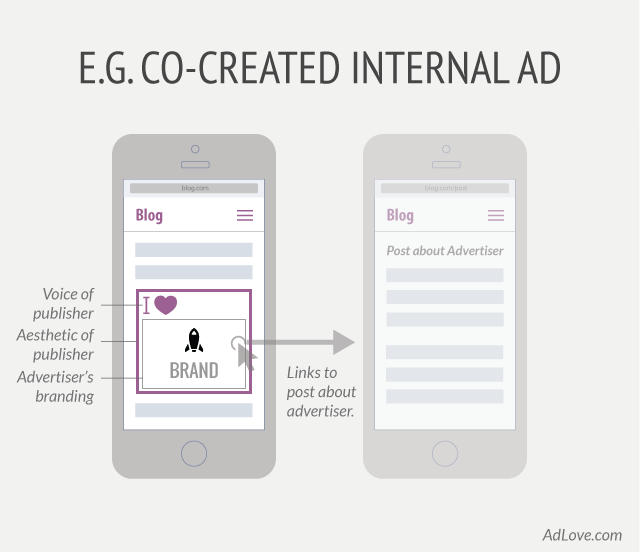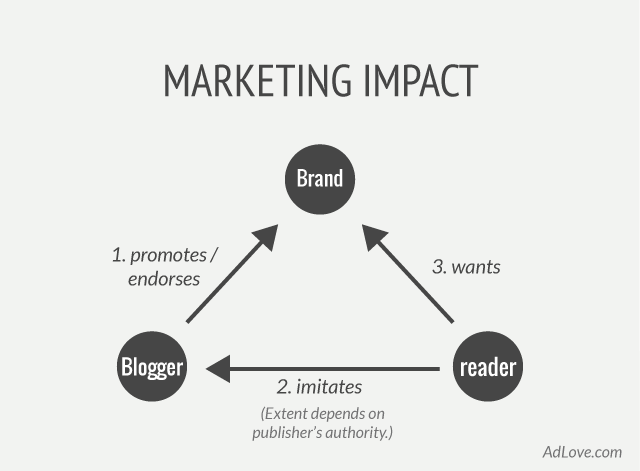Home > Ideas > The Future of Advertising (Jan '21)
The Future of Advertising
There's a simple way to transform ads and the media landscape for the better. It's blindingly obvious, but it has never been adopted to any material extent. Not only would it make ads tolerable, but it would make them wanted. They would become more effective for advertisers and more lucrative for publishers. They would even align the media's incentives with the common good.
The simple change is twofold:
- Co-creation of ads by advertisers and publishers.
- Internal linking of ads within the sites on which they appear.

(If you can't see a diagram above check if your ad blocking software is blocking it.)
Why this fixes everything
User experience
When an ad is co-created by the advertiser and the publisher, it has the potential to meet the intention of the end-user (to consume content created by the publisher). Advertiser-driven creatives contradict this fundamental intention by definition. With this structure the publisher's voice can drive the experience so that it flows with the user's intention.
Differentiation
The single most important decision in evaluating a business is pricing power. If you've got the power to raise prices without losing business to a competitor, you've got a very good business. And if you have to have a prayer session before raising the price by 10 percent, then you've got a terrible business.
By connecting ads to the publisher, they become a differentiated offering. The greater the authority of the publisher, the greater the marketing impact of the ad. Since authority isn't easy to replicate, it can be leveraged into pricing power.

(If you can't see a diagram above check if your ad blocking software is blocking it.)
As well as improving the financial prospects of the publisher, it corrects their incentives. Commodity ad-funded media subjects publishers to a peculiar dynamic where their track record has nothing to do with their pricing power. They neither improve their pricing power with high quality content nor diminish it with low quality content. Their only recourse is to increase circulation. This is a problem because increased circulation can be achieved through less than ideal means. [1]
Privacy
The fundamental misalignment between the intention of the end-user and the advertiser-driven ad forces invasion of privacy. If you can’t meet the user's intention, you have to make up for it by using personal information. This, of course, requires invasive tracking. [2] Such a misalignment doesn't exist for co-created internal ads, so there's no need to track personal information or past browsing behavior.
Liquidity
The immediate objection to this model has to do with liquidity. The model requires double-sided consent from each advertiser-publisher pair, as well as content written by the publisher about the advertiser. This certainly limits the scope of this type of activity, but not to the point of it being impractical. A large and growing number of posts (and advertiser-publisher pairs) are primed for this kind of usage: sponsored posts. The continued growth of this type of content will give this model increasing scope and scale. [3]
Honesty
The problem with sponsored content today is that the publisher gets paid once for a product with a limited shelf life. The post is at the top of the feed for a while, and is soon forgotten. The obligation to keep finding new sponsors has the consequence of diluting the honesty of these posts. Co-created, internally-linked ads can be used to resurface sponsored posts and extend their useful life, reducing the need to compromise to get more revenue.
Technology
One of the alternatives to ad-funded media is subscriptions. While this has worked in a number of cases, it's not clear that it's optimal. At some level it goes against the lines of the internet, which tends to want to operate at any scale there's demand for. The co-created internal ad model allows publishers to let their circulation flex as large as needed. They don't have to trade off monetizing their brand at the expense of furthering it with the widest population possible. [4]
Conclusion
Co-created, internally-linked ads could help put the brakes on, and perhaps reverse, the negative effect on society by a media governed by warped incentives. It could help halt the Orwellian decline of language, reduce the tendency towards polarization, and generally improve our daily experiences. It could help make the democratization of publishing a resoundingly good thing, with a revenue feedback loop that rewards the best actors. [5]
Notes
[1] If your only recourse is to increase page views, you will tend to aim for the largest crowd possible, at any cost. The central way to generate crowds is through scapegoating. In our age this happens in a strange way because of a universal desire not to scapegoat. So scapegoats are produced in the name of defending scapegoats. It rings of hypocrisy, of course, and frequently produces a polarized response of the same character. And so on.
[2] Remarketing involves chasing you around the web based on your prior browsing behavior on an advertiser's site. This kind of works and has been the saving grace of display ads for advertisers. So even in a privacy conscious environment advertisers are incentivized to collect a lot of data.
[3] On a large news site the lifestyle section (travel, fashion etc.) amounts to a huge bank of content that could be used for this purpose.
[4] This has the salutary effect of exposing the maximum number of people possible to high quality media.
[5] This would be an environment where the type of media companies with a track record of being wrong (or tricking you -- e.g. click bait) would have less monetization power relative to the media companies with strong predictive power (e.g. who stand against the crowd and turn out to be right over time). The long-term effect would be better media companies accumulating more resources and scaling their operations and output.
by Aftab Singh, Founder of AdLove (@affalytics) | Ideas home
